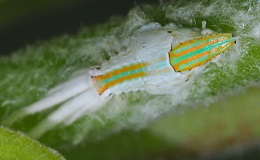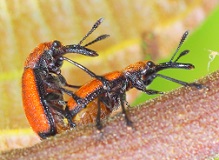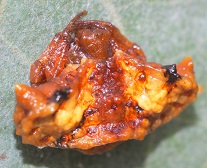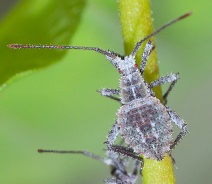| Home | Nature Weekly Index |
4 June 2017 | Nature in the Park | Our Forests |

 After a fruitful outing to the Admiralty Park 2 weeks ago, I did another visit in the following week. One to-do item was
to check on the red Weevil seen the last time to try to ascertain its host plant. With the sighting of a mating pair on the
Rangoon Creeper (Quisqualis indica), I was more certain of their
relationship now.
After a fruitful outing to the Admiralty Park 2 weeks ago, I did another visit in the following week. One to-do item was
to check on the red Weevil seen the last time to try to ascertain its host plant. With the sighting of a mating pair on the
Rangoon Creeper (Quisqualis indica), I was more certain of their
relationship now.
The second to-do item was to investigate the affiliation of a jumping plant louse with the Sea Hibiscus (Talipariti tiliaceum). I first saw one of this plant louse by chance in January, which I now called the Sea Hibiscus Psyllid and likely to be a Mesohomotoma species. As I screened the Sea Hibiscus population in the park more closely during the recent visits, I found a few more of them on this plant. I was hoping to find its nymph to affirm my suspicion. Currently, the closest suspect was a strange elongated insect nymph with orange strips parallel to its body that was found on a Sea Hibiscus. The whitish radiated end of this nymph was actually its tail region though it might look like a head region.

 One of the uncommon sightings was a lone Bird Poo Spider which might be a Pasilobus species. Though its body outline
looked similar to the Pasilobus species seen in 2014,
the finer patterns on its body seemed to be different. I did not expect to see it on a Sea Hibiscus tree. Previously, most
sightings were on the
Nicobar Canoe Tree (Calophyllum soulattri). I doubt spiders had
preference for plant host. They follow their food source.
One of the uncommon sightings was a lone Bird Poo Spider which might be a Pasilobus species. Though its body outline
looked similar to the Pasilobus species seen in 2014,
the finer patterns on its body seemed to be different. I did not expect to see it on a Sea Hibiscus tree. Previously, most
sightings were on the
Nicobar Canoe Tree (Calophyllum soulattri). I doubt spiders had
preference for plant host. They follow their food source.
Three nymphs with red eyes from an unknown bug were found on the stem of a climber, Hogvine (Merremia umbellata). Based on their broad features, they were likely to be a type of Squash Bug (Family: Coreidae).
There were obviously a lot more seen than shared here. These days, my focus had shifted toward the minibeasts since there were much more interesting stuffs to be uncovered in that sector. As for plants, there were many more resources now compared to about 10 years back when I first started my website. For example, the Urban Forest website that focus on plant identification in Singapore was re-launched recently with more friendly navigation features. As for my website, not much will change on the format except for the periodic addition of new materials and information since it is not top of my priority list of to-do things.
The other more prominent Singapore nature news that I read in the local press recently was about the world-first discovery of live specimen of the T Rex Ant (Tyrannomyrmex rex) in Mandai forest. Probably a ripple effect, the press published an article last Sunday indicating 480 new species discovered in Singapore and almost 150 species were world firsts. If there are that many precious gems residing in our forest, why are we still endangering our MacRitchie Forest?
Update: 9 July 2017
The identity of the unknown squash bug nymph found on the Hogvine should be Acanthocoris scaber. In early July 2017, I spotted another population of nymphs in another park but on the Sweet Potato (Ipomoea batatas) creeper.